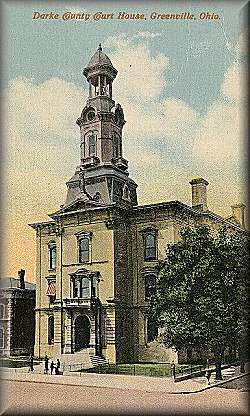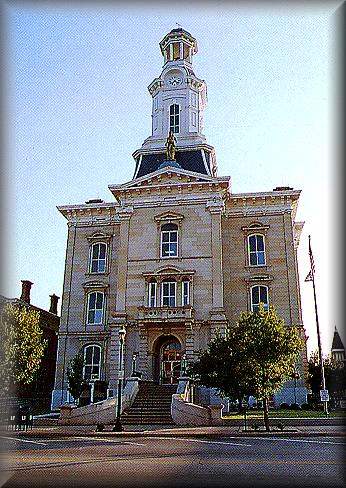


HISTORY
OF
DARKE COUNTY
OHIO
From Its Earliest Settlement to the
Present Time
IN TWO VOLUMES
VOLUME I & II
BY FRAZER E. WILSON
Also Biographical Sketches of Many Representative
Citizens of the County.
ILLUSTRATED.
MILFORD, OHIO.
THE HOBART PUBLISHING COMPANY
1914.
DARKE COUNTY COURTHOUSE, GREENVILLE, OHIO



![]()
![]()
TRY THE NEW SEARCH ENGINE AND LET ME KNOW HOW IT WORKS
SEARCH ENGINE NUMBER ONE When you reach the page you have been referred to by the search engine, search this page
by going to the top of your browser, click Edit and then click find on this page. Type in the desired search word and click. This will take you to the places on
the page where this word is found. It will take you through all of the places that this word is found on this page INDEX VOLUME I INDEX VOLUME II "Not to know what happened before we were born is to remain always a child. For what were the
life of man did we not combine present events with the recollection of past ages?" —Cicero. FOREWORD A comprehensive county history must, of necessity, be a compilation of materials gleaned from
various sources and assembled in the form of a literary mosaic, the design of which is
symmetrical—but not always apparent. The first and only exhaustive history of the county heretofore written was published by W. H.
Beers & Co., in 1880, from material compiled and arranged largely by Judge John Wharry of
Greenville and by one Prof. W. H. -McIntosh. This volume contained about 250 octavo pages of
closely printed matter relating to the history of the county, besides about 200 pages of general
introductory material and about 300 pages of biographical sketches. On account of its priority
and the mass of historical data which it contains, this book must form the basis of any authentic
history hereafter written. Perhaps the most apparent fault in this excellent first history is the lack
of an adequate index and the irregular arrangement of topics—a condition which the writer has
endeavored to overcome in a measure in this work. A second work entitled "A Pictorial Outline History of Darke County," was published by Geo.
W. Wolfe in 1890. This work was largely biographical but contained some excellent introductory
matter and a few good topical sketches. An excellent Biographical History was published in 1900 by the Lewis Publishing Company of
Chicago, which contained many well-written biographical sketches, but not much purely
historical data. To all of these works the compiler of the present volume freely acknowledges his
indebtedness for original material, realizing that without them the task of writing an authentic
pioneer history would be practically impossible. Further acknowledgment is made to Attorney Geo. A. Katzenberger, who compiled and wrote the
excellent chapters on "Miltia Organizations," and "Bench and Bar;" and to Geo. FOREWORD W. Calderwood, the "Darke County Boy," whose writings made possible the chapter entitled
"Random Sketches." Others who have assisted materially in making this work possible are mentioned in the body of
this book. The military campaigns of St. Clair and Wayne are treated somewhat exhaustively inasmuch as
they led up to the great treaty of Greene Ville, which is one of the landmarks of state and national
history. Much space has also been devoted to the interesting geological and archeological features of the
county, which have been given scant treatment in former works. An attempt has been made to give a brief history of every religious denomination having a fair
constituency in the county and thereby preserve a permanent record of the founding of each for
convenient reference. The writing of a county history covering the numerous phases of political, social, religious and
material progress is a large but interesting task, and it is the hope of the author of this work that
the careful perusal of its pages will stimulate greater interest in local history than has been
manifested heretofore and be a source of delight to many. Probably the greatest difficulty encountered in the present work has been the matter of the
arrangement of the vast amount of miscellaneous material collected. This has been overcome, in
a measure, by considering the relation of each subject to the history of the county as a whole
rather than to a restricted locality. An entire chapter is given to "Notable Events" as it is deemed desirable to portray these
significant historical happenings for the instruction and entertainment of future generations. The recent introduction of the study of local history in our public schools is a commendable step
and will, no doubt, result in a widespread interest in and enthusiasm for pioneer lore, so that the
records of the past will be more eagerly perused and the memory of early events more sacredly
cherished by coming generations. Instead of contempt for the past we may expect appreciation,
and look for a more vivid realization of the fact that the things of the past play an important part
in the life of the present. Some one has aptly said: "The average American is content to let history begin with himself,"
exhibiting thereby an ignorance and indifference unworthy of citizenship in a repub- FOREWORD lic bought with blood and sacrifice. Such persons should read and ponder on these beautiful lines
by Cora Greenleaf: There is No Past. "They are not dead, those happy days gone by, They brought that much of life to us. And I Know no part of our life can ever die. We lived them, so each joy or grief fraught day Is ours, henceforth, forever and for aye, There is no dead, unknowing yesterday. Our memory the casket that shall hold Experiences worth far more than gold And jewels to the longing soul they mold. I like to drift and dream of times called past, Past days are present long as memories last, Within the brain's firm mold they're poured and cast Shaped in an instant by our heedless will, To last forevermore, for good or ill, Until this very universe grows chill." It will be noticed that this work appears in two volumes, the first of which is historical and is
compiled by the author, while the second is biographical and is the work of the publishers to
whom credit is due for its excellent and comprehensive character. FRAZER E. WILSON. Greenville, Ohio, May 20, 1914. CONTENTS CHAPTER I—PRIMEVAL DARKE COUNTY----------------17 Early Records—Niagara Limestone—Later Formations—Glacial Invasion—The Laurentide
Glacier—Terminal Moraine—Local Glacial Phenomena: (1) Surface Boulders, (2) Glacial Till,
(3) Kames—Local Moraines: (1) Miami Moraine, (2) Union Moraine, (3) Mississinawa
Moraine—Extinct Animals—Peat Bogs. CHAPTER II—ACHEOLOGY AND TOPOGRAPHY--------33 The Mound Builders—Local Phenomena—Indian Camp Sites and Vilages—Flint
Caches—Work Shops—Stone Pipes and Implements. Topography: Forests—Game. CHAPTER III—THE OHIO COUNTRY--------------------49 Early Indian Tribes—Early French Explorations—Colonial Expansion—French and Indian
War—Anglo-Saxon Ascendency—Clark's Expedition—Retreat of the Tribes—Raids and
Retaliations—Ordinance of 1787—Settlements North of the Ohio. CHAPTER IV—HARMAR AND ST. CLAIR----------------- 73 St. Clair Appointed Governor—Government Instituted—Harmar's, Scott's and Wilkinson's
Expeditions—Confederation of the Tribes—St. Clair's Expedition and Defeat. CHAPTER V—MAD ANTHONY WAYNE------------------- 93 Overtures of Peace—Council of the Tribes—Wayne Succeeds St. Clair—Army
Reorganized—Wayne Advances and Builds Fort Greenville—Fort Recovery Attacked—Army
Advances to the Maumee—Battle of "Fallen Timbers." CHAPTER VI—THE GREAT PEACE------------------------107 British Encourage Indians—Peace Overtures—Tribes Assemble at Greenville—Preliminary
Negotiations—Smoking the Pipe of Peace—The treaty of Greene Ville. CHAPTER VII—TECUMSEH AND THE “PROPHET"-----121 Settlement at Prophetstown—Teaching and Conniving—Visit of the Shakers—Hanging of Blue
Jacket—Departure for Tippecanoe. CHAPTER VIII—PIONEERS AND PIONEER SETTLEMENTS --139 The Herdman Family—The French Trader—Azor Scribner—Samuel C. Boyd—Abraham
Studabaker—John Devor and Others, —War of 1812—Murder of Andrew Rush, The Wilson
Children, Elliott and Stoner—Harrison's Treaty—Early Land Purchases—Renewal of
Emigration—Local Settlements. CHAPTER IX—CREATION AND DEVELOPMENT OF THE COUNTY--165 Early Trails and Roads—Early Neighborhood Settlements—Early Business Enterprises—Early
Taverns—Early Mills—Early Schools. CONTENTS CHAPTER X—THE PLATTING OF THE CHURCH-------197 Jesuit Missionaries—Army Chaplains—Rev. Morgan J. RhysThe Denominations: Christian,
Methodist, Presbyterian, Episcopal, Baptist, Catholic, United Brethren, Lutheran, German
Baptists, Church of the Brethren, Evangelical, Universalist, Reformed, Church of Christ—Other
Denominations—County Sunday School Association. CHAPTER XI—RANDOM SKETCHES FROM THE "DARKE COUNTY BOY" -- 253 Social Life: Winter Sports, Singing School, Dancing, Circus Lore, Rowdyism, Children's
Pastimes, Sunday Observance, Games, Drinking, The Old Band, Early Fairs—Domestic Life:
Early Mothers, Clothing and Fashions, Household Equipments, Early Notables, Early
Superstitions, Obsolete Trades, Etc. Events of 1856—Ancient Landmarks: "Kentucky Point,"
"Armstrong's Commons," "Spayde's Woods," "Goosepasture and Bunker Hill," "Wayne Avenue
and Wayne's Treaty," "Old Court House," "Indian Trail," "Beech Grove" and "Matchett's
Corner." CHAPTER XII—DARKE COUNTY DURING THE CIVIL WAR-- 293 Local Patriotism—Preparation for the Conflict—Early Enlistments—Departure for the
Front—Ohio Regiments Represented 11th Regiment, 34th Regiment, 40th Regiment, 44th
Regiment, 8th Ohio Cavalry, 69th Regiment, 94th Regiment, 110th Regiment, 152d Regiment,
187th Regiment, and Others. CHAPTER XIII—SOME NOTABLE EVENTS ------------- 303 Harrison's Treaty 1814—Washington's Centenary Celebration, 1832—Departure of the Tribes,
1832—Hard Cider Campaign of 1840—Burial of Patsey and Anna Wilson, 1871—Dedication of
Court House, 1874—Wayne Treaty Centennial, 1895—Unveiling of the Wayne Treaty
Memcrial, 1906—Dedication of the Fort Jefferson Memorial, 1907. CHAPTER XIV—SOME NOTABLE CITIZENS--------------327 Major George Adams—Azor Scribner—Abraham Studabaker -Edward B. Taylor—Dr. I. N.
Gard—D. K. Swisher—Enoch B. Seitz—Barney Collins—"Annie Oakley," and Others. CHAPTER XV—POLITICS AND POLITICAL OFFICES--- 355 Early Political Conditions—"Ante Bellum" Days—After the War—State
Senators—Legislators—County Officials: Commissioners, Treasurer, Recorder, Auditor,
Surveyor. CHAPTER XVI—PUBLIC INSTITUTIONS -----------------365 Infirmary—Children's Home—Carnegie Library—Public Museum —Henry St. Clair Memorial
Hall. CHAPTER XVII—RAILWAYS ------------------------------383 Early Means of Transportation—Railways in Darke County: The Dayton and Union, The
Pennsylvania, The C., C., C. & St. L., The Peoria and Eastern, The Cincinnati Northern, The C.,
H. & D., The Ohio Electric. CHAPTER XVIII—THE PRESS -----------------------------395 Influence of the Press—Early Illiteracy—First Newspapers—The Journal—The Democrat—The
Courier—The Tribune; Daily, Weekly—The Advocate; Daily, Weekly —German Newspaper
—Temperance Papers—The Versailles Policy—The Versailles Leader—The Arcanum
Enterprise—The Arcanum Times—The Ansonia Herald—The Bradford Sentinel—The New
Madison Herald—The Hollansburg News—Others. CONTENTS CHAPTER XIX—FINANCIAL INSTITUTIONS ------------ 405 Banks—Development of the Banking System—Early Scarcity of Money—Early Money
Lenders—The Farmer's National Bank—The Greenville National Bank—The Second National
Bank—The Citizens Bank—Banks at Versailles, New Madison, Ansonia, Arcanum, Gettysburg,
Pittsburg and Rossburg—Building and Loan Associations: Greenville Building Company,
Citizen's Loan and Saving Association, Arcanum, Versailles and New Madison Loan
Associations. CHAPTER XX—DARKE COUNTY AGRICULTURAL SOCIETY-- 415 Agricultural Prominence of Darke County—Demand for a Fair—The First Fair, 1853—Growth
of the Fair—Notable Fairs—Purchase and Enlargement of Grounds—Present
Equipment—Comprehensive Policy—Present Tendencies—Present Board. CHAPTER XXI—PATRIOTIC, TEMPERANCE AND OTHER SOCIETIES -- 425 Jobes Post, G. A. R.—Complete Roster of Jobes Post—W .R. C. —S. of V.—W. C. T.
U.—Pioneer Association—Historical Society—Medical Association. CHAPTER XXII—BENCH AND BAR, by George A. Katzenberger, Attorney-at-Law
---------------------------------------- 449 First Courts—Place and Manner of Convening—Early Jurisprudence—First Recorded
Trial—First Justices of the Peace—First Jails and Court Houses—First Associate
Judges—Constitution of 1851—Development of the Circuit, Common Pleas and Probate Court
System—Biographical Sketches of Common Pleas Judges, Probate Judges and Prosecuting
Attorneys—List of Sheriffs and Clerks of the Court from the Organization of the
County—Biographical Sketches of Early Attorneys—The Present Bar. CHAPTER XXIII—LOCAL MILITIA ORGANIZATIONS, by Lieutenant George A.
Katzenberger ------------------------- 503 General Remarks—Military System of Ohio—Early Military Officers and Organizations—Maj.
George Adams—Brig.-Gen. William Emerson—Maj.-Gen. Hiram Bell—Gen. J. H. Hostetter
—Capt. Jonathan Crainor—The Greenville Guards—The Greenville Jaegers—Captain
Beers—Company C, 3d Regiment—Detailed History of Company M, 3d Regiment. of Military
System. CHAPTER XXIV—THE COUNTY SEAT-------------------513 Advantageous Location—Directory of 1857—Development of the Town in 1857—Development
by Decades—Notable Buildings—Public Utilities: Water Works, Electric Light, Home
Telephone, Fire Department, Post Office, Cemetery, Public Schools, Lodges, Societies and
Clubs—City Officials, BRIEF TOWNSHIP SKETCHES --------------------------- 546 Arrangement of the Townships—Treatment by Tiers in the Following Order: Mississinawa,
Jackson, Washington, German, Harrison, Allen, Brown, Greenville, Neave, Butler, Wabash,
York, Richland, VanBuren, Twin, Patterson, Wayne, Adams, Franklin, Monroe. 40
![]()
![]()
![]()